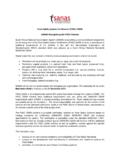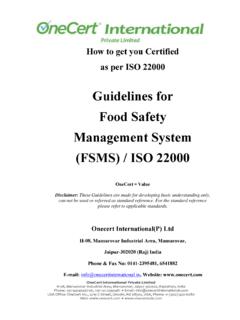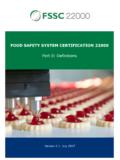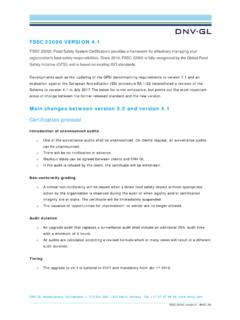Transcription of FSSC 22000 - maisystem.co.jp
1 FSSC 22000 ISO22000:2005 PRPs Certification scheme for food safety systems in compliance with ISO 22000 : 2005 and technical specifications for sector PRPs PART I REQUIREMENTS FOR ORGANIZATIONS THAT REQUIRE CERTIFICATION I Gorinchem, :2015 Foundation for food safety Certification Gorinchem, The Netherlands: 2015 2015 2 26 FSSC 22000 BSI PAS 223 ISO/TS 22002-4 Version Control Version Published on 26 February 2015 Reason for change All scheme documents updated from version to extend the scope to include animal production, to include the link with voluntary FSSC 22000 quality module and to replace BSI PAS 223 by ISO/TS 22002-4 I 1. 3 2. 4 3.
2 5 5 5 5 5 IA 9 IB 11 CONTENT 1. INTRODUCTION .. 3 2. SCOPE .. 5 3. REQUIREMENTS FOR THE food safety SYSTEM .. 6 food safety management system .. 6 Prerequisite programmes .. 6 Additional requirements .. 6 Appendix I A .. 9 Appendix I B .. 11 2 I 1. 1. INTRODUCTION Purpose This part of the scheme contains the requirements for organizations in the food chain to gain certification.
3 They shall be used by the organization to assess, develop, implement and improve its food safety system and to apply for certification. The requirements of the food safety system also serve as the normative requirements for certification of the organization. They shall as such be used by the certifying body to assess the continuous compliance of the food safety system that is developed and implemented by the organization. Guidance is also given to the CBs and the organizations on the application process for certification. 3 I HACCP ISO 22000 ISO 22000 ISO HACCP ISO 9001 ISO 22000 food safety management and HACCP For the greater part the requirements are based on the standard ISO 22000 .
4 ISO 22000 was developed by the International Organization for Standardization (ISO) and fulfils the need of: a worldwide food safety standard that is developed and owned by an independent international organization; international harmonization of the requirements of food safety systems; integration of the technological ( Good practices, HACCP, traceability) and legal food safety requirements in the quality management system requirements of standard ISO 9001; a food safety standard that is applicable to the whole supply chain and that requires any organization in the chain to take into account the hazards of the final product of the chain. Based on this ISO 22000 is considered the most appropriate standard for the food safety management system to be included in this scheme. 4 I ISO 22000 PRPs Codex Alimentarius Codex Alimentarius ISO 22000 PRPs Global food safety Initiative of the Consumer Goods Forum (GFSI) ISO 22000 PRPs ISO 22000 ISO 22000 FSSC 22000 PRPs Prerequisite Programmes (Good Manufacturing Practice)
5 An important prerequisite for ensuring food safety is that organizations in the food chain maintain the conditions for hygienic environment and production. ISO 22000 requires in clause that organizations shall select and implement specific Prerequisite programmes (PRPs) for these basic hygiene conditions and shall consider and utilize appropriate information when selecting the program ( the requirements as prescribed in the General principles of food hygiene of the Codex Alimentarius, specific codes of practices of the Codex Alimentarius, food safety legislation and possible customer requirements). It does not specify these requirements as the standard is applicable to the whole food chain and the basic hygiene requirements may vary considerably between sectors. In order to create explicitness on the requirements for PRPs and to allow for a benchmark of ISO 22000 certification schemes by customers ( Global food safety Initiative of the Consumer Goods Forum (GFSI)).
6 Stakeholder organizations have developed detailed technical specifications covering sector PRPs. These technical specifications can be used in addition to ISO 22000 to provide further detail for chapter of ISO 22000 . FSSC 22000 provides a certification scheme for sectors where such a technical specification for sector PRPs has been realised as described in the scope (see also chapter Scope of the scheme ). 5 I ISO 22000 PRPs I IA 3 3 Additional requirements To meet the needs of the key stakeholders and to ensure an adequate control of food safety , specific requirements for the food safety system are included in this scheme.
7 These may be elaborations of the clauses in ISO 22000 and technical specifications for sector PRPs or additional requirements and are included in the section Additional requirements (Part I, Appendix IA). When it appears from the three year review of the scheme by the Board or when the Board decides in one of its three annual meetings that the requirements given in the standards need to be amended or appended, these changes are also included in this section. 6 I 2. Featur es of the scheme ISO/TS 22003 PRP A ISO/TS 22002-3 IA C ISO/TS 22002-1 IA D ISO/TS 22002-1 IA E ISO/TS 22002-1 IIA F PAS 222 IA L ( ) ISO/TS22002-1 IA M ISO/TS 22002-4 IA 7 I 2.
8 SCOPE The requirements in this document are set out for the assessment of food safety systems (see also chapter Features of the scheme ): Category codes ISO/TS 22003 Categories Examples of sectors Applicable PRP Technical Specification Additional requirements A farming 1 (Animals) limited to farming animals, fish, egg production, milk ISO/TS 22002-3 Appendix IA C perishable animal products meat, poultry, eggs, dairy and fish products ISO/TS 22002-1 Appendix IA D perishable vegetal products packed fresh fruits and fresh juices, preserved fruits, packaged fresh vegetables, preserved vegetables ISO/TS 22002-1 Appendix IA E products with a long shelf life at ambient temperature canned products, biscuits, snacks, oil, drinking water, beverages, pasta, flour, sugar, salt ISO/TS 22002-1 Appendix IA F feed Production Single ingredient and compound feed and premix animal feed, fish feed PAS 222 Appendix IA L (bio)
9 Chemical manufacturing food ingredients vitamins, additives, and bio- cultures but excluding technical ISO/TS 22002-1 Appendix IA 8 I and technological aids M food packaging material manufacturing direct, indirect contact with the food ISO/TS 22002-4 Appendix IA The requirements are applicable to organizations in the food chain regardless of size and complexity, whether profit-making or not and whether public or private. 3. ISO 22000 :2005 3. REQUIREMENTS FOR THE food safety SYSTEM food safety management system The requirements for the development, implementation and maintenance of the food safety management system are laid down in the standard ISO 22000 :2005 food safety management systems - Requirements for any organization in the food chain.
10 ISO 22000 PRPs ISO 22000 PRPs PRPs Prerequisite programmes When establishing, implementing and maintaining the Prerequisite programmes (PRPs) in accordance with clause of ISO 22000 , the organization shall in addition to ISO 22000 requirements consider and utilise the requirements of technical 9 I specification for sector PRPs. Apart from these requirements, other appropriate information shall be considered and utilised especially: regulatory requirements, recognized sector or product group codes of practices and guidelines, customer requirements.




